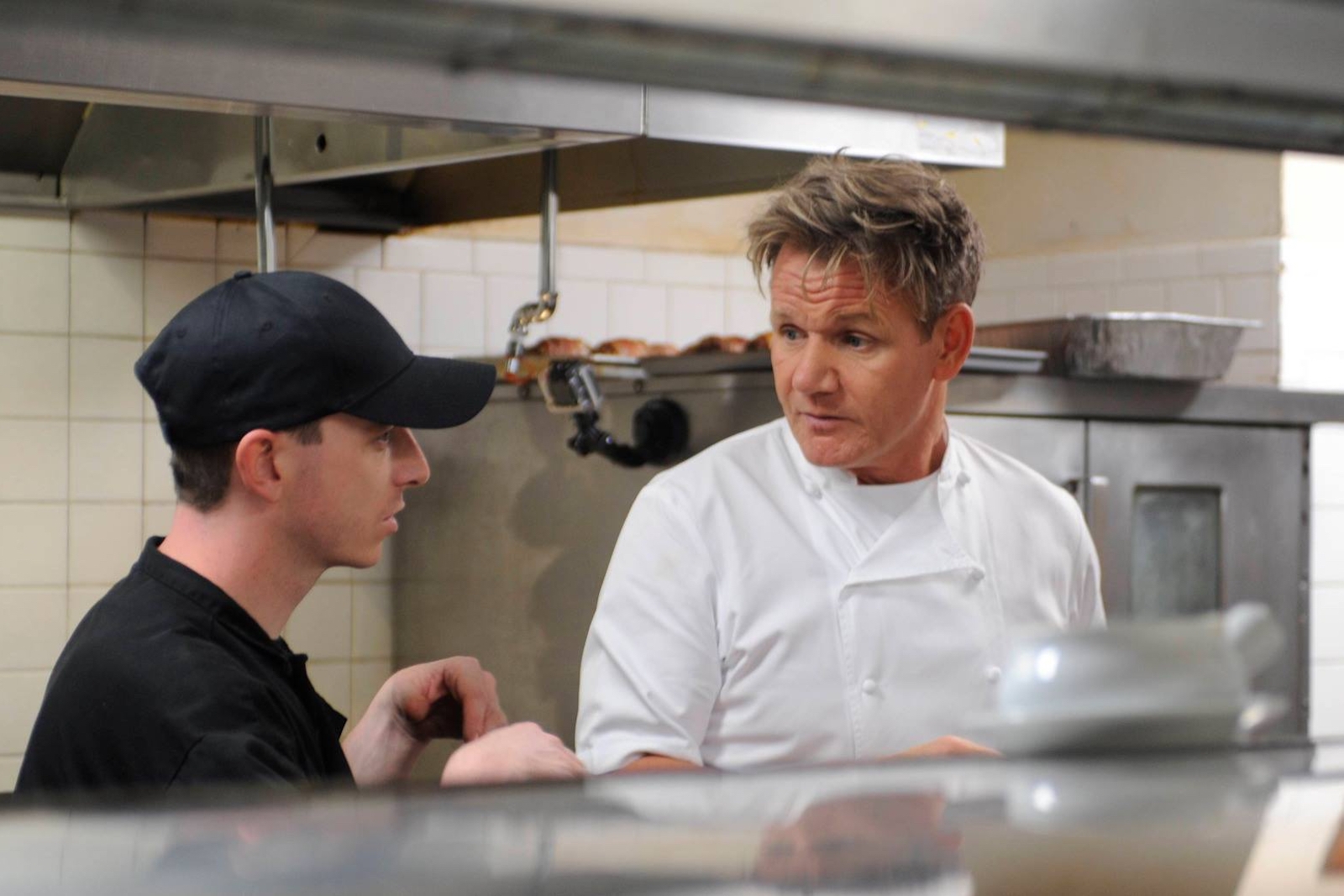
Gordon Ramsay’s ‘Kitchen Nightmares’ is Comfort Food
The template to an episode of Kitchen Nightmares is pretty standard, and hardly ever deviates: a restaurant is on hard times; owners, managers, and waitstaff point fingers while still claiming that their food is top-notch. These are small, private restaurants, usually family-run and operated. They openly plead with Gordon Ramsay to come save them as if he were some deity, a reality TV genie capable of granting their wishes.
And then he arrives. Sometimes he walks in sporting a leather jacket and jeans; other times, he’s in his standard white chef’s jacket; occasionally, he rolls up on a motorcycle. He is the epitome of cool. Ramsay walks into these restaurants with a swagger like he’s the quarterback of the high school football team; the men get firm handshakes, the women get kisses on the cheek and called “my darling.”
Ramsay always asks the restauranteurs how they rate their food, and they always speak very highly of it. Nevertheless, they claim their business is failing and that they are deeply in debt, many to the level of hundreds of thousands of dollars.
But once the formalities are over, it’s time for Ramsay to sample the food, and he’s usually revolted at what he finds. He can normally only take a couple of bites before dismissing the dish entirely. He then usually goes to the kitchen and berates the staff for their lackluster performance. Some will acknowledge it; others will smugly deny there’s a problem in the first place. Those are the really good episodes.
Then, it’s dinner service, and Chef Ramsay looms large; after all, this is his domain. And he has probably gone on to investigate the situation on his own while everyone is either distracted or busy. What he finds are truly among the most stomach-churning moments on the show: rotten, contaminated or expired food, nothing fresh; unsanitary conditions; kitchens that haven’t been cleaned in a long time. Lazy or incompetent kitchen staff have made shortcuts or overestimated the amount of food they should have in stock. Around this time, plates are starting to be sent back, as angry customers are made to wait for substandard food.
For some of the more egregious offenders, Ramsay demands that they shut dinner service down rather than risk some of the contaminated food getting into the customers’ stomachs. Ramsay, flabbergasted, gives the owners and staff a proper verbal thrashing usually involving variations of the word “fuck,” questioning why things were allowed to go on like this for so long. He stomps away, disgruntled and reviled, as the shaken staff is forced to confront their own haphazard management.
This is the formula, hardly any episode deviates from it, it’s what makes it a guilty pleasure, and yet we keep coming back for more. Kitchen Nightmares ran for 92 episodes across a 7-season span lasting from 2007 to 2014. It was based on Ramsay’s original hit show in the United Kingdom, Ramsay’s Kitchen Nightmares. UK airings of the U.S. adaptation have an alternate soundtrack and mix with less prominent musical stings, a lower level of vocal compression, and a different narrator than the U.S. broadcast.
The original British show seems more about the actual cooking, but in translating the concept for American audiences, the drama was ramped up, and there’s an Extreme Makeover-esque restaurant renovation element. This happens right when the owners are at their lowest point: they’ve been embarrassed by or in front of Chef Ramsay, they’re coming to grips with the decisions that they made that have led to this point, and they’re considering radical changes to maintain the business.
But then, like a fairy godfather, Ramsay grants their wishes and makes their dreams come true: a refurbished restaurant interior complete with state-of-the-art technology and the latest aesthetic trends, an updated menu meant to capitalize on the restaurant’s strengths, and Ramsay’s guided expertise during relaunch night.
Ramsay is, of course, no stranger to television. By my count, Kitchen Nightmares is one of thirteen reality shows, eight of them American, that Ramsay has hosted or been a part of over the years. But this show has become a surprise streaming-era success in no small part due to its easy and free availability on YouTube. It may be anecdotal, but when I would mention that I was watching the series to friends and loved ones, oftentimes, they too would admit to falling down the Kitchen Nightmares rabbit-hole.
There are classic highlight episodes everyone knows about at this point, like the one featuring the now-defunct Amy’s Baking Company, the only time Ramsay walked out of helping a restaurant because of the outrageous behavior of restaurant owners Amy and Samy Bouzaglo. Another highlight is an episode featuring Capri, a run-down pizzeria run by two slovenly middle-aged twin brothers named Jim and Jeff who Ramsay has to whip into shape to save their struggling business. And don’t get me started on the two Italian sisters in Boston who become enamored with Ramsay, one going so far as to chase after him as he’s leaving.
The show spoke to something during the pandemic, to everything we missed about going out to eat at a restaurant, but also some of what was not missed when taking a risk on a less-than-reputable establishment. The food that Ramsay helps prepare for the relaunch night always looks downright delectable; how disgusting, dirty and filth-ridden the kitchens and fridges look when Ramsay first gets there indicates they may be the origin point of the next global pandemic.
It also gives me insight into our reality-TV world. Ramsay really is framed in heroic terms: never wrong, giving the harsh but warranted criticism in ways that range from drill sergeant to doting benefactor. I think that’s deliberate. To what extent the show is “real,” I couldn’t tell you. I think it’s probably more genuine than professional wrestling, but I imagine things are heightened or exaggerated, particularly in the editing process. We are seeing multiple days cut down to 45 digestible minutes filled with the juiciest, most dramatic moments that happened. But there is a website that monitors what happened to the restaurants after Ramsay visited them, with most of them closing within a few years of being on the show.
I understand better now how reality TV manipulates us. We all love an inspirational story, and here is a fairy tale come true almost 100 episodes over. We start to believe things about reality TV hosts, maybe that they’re invincible or infallible. After all, the shows want us to engage in that narrative, it’s the one they’re selling. But what happens when reality TV hosts start believing that narrative themselves, denying that they’re not as smart, powerful, or impressive as when they’re on TV, and take a run at politics?
Thankfully, Gordon Ramsay’s sole interest (for now) continues to be culinary arts, and no Machiavellian plots for world domination or attempted coups have emerged from his portfolio. I noticed this thing in the mid-to-late-2000s where Americans loved to be yelled at by British men on reality TV shows, the most prominent examples being Ramsay and Simon Cowell on American Idol. I think the difference was that Ramsay offered a “tough-love” in contrast to Cowell’s heightened smugness.
My family and I went to a restaurant that had been featured on a subsequent show called Gordon Ramsay’s 24 Hours to Hell and Back in Richmond, VA. There is an aura when you invoke his name that elicits both joy and fear. It harkens back to the episodes where you don’t think there’s any way that Ramsay and the owner will make peace, only to have the two exchange hugs upon Ramsay’s departure.
Right as he’s out the door, Ramsay will offer a short reflection of the experience to the camera, recounting some of the lows of the week, but mostly the pride he usually has for the restaurant, its owners and staff rising to the occasion, and that he hopes for their continuing good fortune and future success. He’ll then make one final pithy reference to something earlier in the episode while walking away.
We like that level of assurance; we like to experience the joy of rooting for the underdog; we like a heroic mentor figure who can move in quickly, always make the right calls and help us make startling transformations; and we love to eat, occasionally in restaurants. Kitchen Nightmares sums up so much of the human experience, in 45 minutes, for free on YouTube. No wonder so many, myself included, ended up gravitating towards it amidst a global pandemic.

